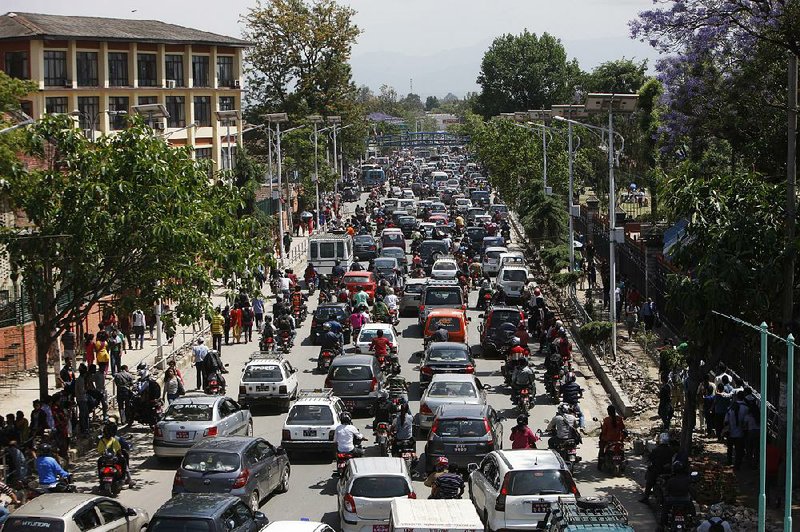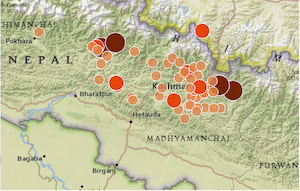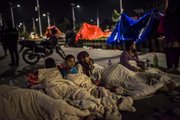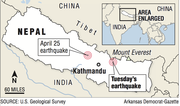KATHMANDU, Nepal -- A new earthquake killed dozens of people Tuesday and spread more fear and misery in Nepal, which is still struggling to recover from a quake nearly three weeks ago that left more than 8,000 dead.
A U.S. Marine Corps helicopter carrying six Marines and two Nepalese soldiers was reported missing while delivering disaster aid in northeastern Nepal, U.S. officials said, although there were no immediate indications the aircraft crashed.
Tuesday's magnitude-7.3 quake, centered midway between Kathmandu and Mount Everest, struck hardest in the foothills of the Himalayas, triggering some landslides. It also shook the capital badly, sending thousands of terrified people into the streets.
Nepal's Parliament was in session when the quake hit, and frightened lawmakers ran for the exits as the building shook and the lights flickered out.
At least 37 people in Nepal were killed in the quake and more than 1,100 were injured, according to the Home Ministry. That toll was expected to rise as reports began reaching Kathmandu of people in isolated Himalayan towns and villages being buried under rubble, according to the United Nations' Office for the Coordination of Humanitarian Affairs.
Tremors radiated across parts of Asia. In neighboring India, at least 16 people were confirmed dead after rooftops or walls collapsed onto them, according to India's Home Ministry. The earth also shook strongly in Tibet, unleashing a landslide that killed one person and injured three, according to China Central Television.
The magnitude-7.8 earthquake that hit April 25 killed more than 8,150 and flattened entire villages, leaving hundreds of thousands homeless in the country's worst-recorded quake since 1934. The U.S. Geological Survey said Tuesday's earthquake was the largest aftershock to date of that destructive quake.
Tuesday's temblor was deeper, however, coming from a depth of 11.5 miles versus the earlier one at 9.3 miles. Shallow earthquakes tend to cause more damage.
After the latest quake, at least three people were rescued Tuesday in Kathmandu and another nine were pulled to safety in the district of Dolkha, the government said.
Rescue helicopters were sent to mountain districts where landslides and collapsed buildings may have buried people, the government said. Home Ministry official Laxmi Dhakal said the Sindhupalchowk and Dolkha districts were the worst hit.
Prakash Banjara, an engineering student, was on an aid mission with 15 other students, delivering rice to remote villages in Sindhupalchowk district, when "the earth started shaking so violently."
"The mountains before my eyes started tumbling down in massive landslides," Banjara said by telephone. He asked for help for his small group of volunteers, now stranded by landslides on an isolated road, unable to contact police and fearing the approach of a predicted storm.
"We are clinging together on the road, hoping the clouds will go away," he said. "I saw buildings crumble as we made our way here. Maybe there are people trapped in them. We have no way of knowing yet."
Search parties fanned out to look for survivors in the wreckage of collapsed buildings in the Sindhupalchowk town of Chautara, which had become a hub for humanitarian aid after last month's quake.
Even before Tuesday's earthquake, impoverished Nepal had appealed for billions of dollars in aid from foreign nations, as well as medical experts to treat the wounded and helicopters to ferry food and temporary shelters to hundreds of thousands left homeless amid unseasonal rains.
In Washington, Navy Capt. Chris Sims said the missing Huey helicopter was conducting disaster relief operations near Charikot, Nepal.
A nearby Indian helicopter heard radio chatter about a possible fuel problem, said U.S. Army Col. Steve Warren. The Huey, carrying tarps and rice, had dropped off supplies and was headed to a second site when contact was lost, he said, adding that there had been no smoke or other signs of a crash.
Marines in V-22 Osprey aircraft searched unsuccessfully near the helicopter's last known location for about 90 minutes, Warren said. Members of the Nepalese army were searching on foot, he added.
Because of the rugged terrain, the helicopter could have landed in an area where the crew was unable to get a beacon or radio signal out, Warren said.
'Back to the pain'
Tuesday's earthquake struck just as ordinary life was returning to Nepal, its streets once again alive with vegetable markets and dumpling stands.
Jasmine Avgerakis, who is stationed in Sindhupalchowk with the charity Mercy Corps, said she has watched people overcome the trauma of the first earthquake, roll up their sleeves and set about cleaning up.
"They were just starting to go home and feel comfortable there," she said.
Tuesday's quake, she said, brought "the sight of panic. Children were crying. Seeing them run from their homes to this field; there was just so much fear in their faces. They had been starting to move on slightly, in areas that had the means to."
With the new earthquake, she said, "they went back to the pain again."
Tuesday's quake was followed closely by at least 10 strong aftershocks, according to the U.S. Geological Survey.
Since the April 25 quake, people across Nepal have feared another powerful one, in part because the first one left many buildings unstable, and many people refused to sleep indoors for more than a week.
Frightened residents in the capital, who had returned to their homes only a few days ago, once again set up tents Tuesday night with plans to sleep in empty fields, parking lots and on sidewalks.
"Everyone was saying the earthquakes are over. ... Now I don't want to believe anyone," said produce vendor Ram Hari Sah, 40, as he searched for a spot to pitch an orange tarpaulin to shelter his family. "We are all scared; we are terrified. I would rather deal with mosquitoes and the rain than sleep in the house."
"I thought I was going to die this time," said Sulav Singh, who had rushed with his daughter into a street in the suburban neighborhood of Thapathali after the quake. "Things were just getting back to normal, and we get this one."
Paul Dillon, a spokesman with the International Organization for Migration, said he saw a man in Kathmandu who had apparently run from the shower with shampoo covering his head when the quake hit. "He was sitting on the ground, crying," Dillon said.
Extra police were sent to patrol the areas where residents were camping, while drinking water and extra tents were being provided, Kathmandu administrator Ek Narayan Aryal said.
Meanwhile, new landslides blocked mountain roads in the district of Gorkha, one of the regions hit hardest April 25, while previously damaged buildings there collapsed with the latest quake.
Residents of the small town of Namche Bazaar, about 35 miles from the epicenter of Tuesday's quake and well-known to high-altitude trekkers, said a couple of buildings damaged earlier had collapsed there as well. But there were no reports of deaths or injuries.
Information for this article was contributed by Binaj Gurubacharya, Katy Daigle, Tim Sullivan, Indrajit Singh, Didi Tang and Lolita C. Baldor of The Associated Press and by Ellen Barry, Austin Ramzy, Chris Buckley, Hari Kumar, Suhasini Raj and Nida Najar of The New York Times.
A Section on 05/13/2015



